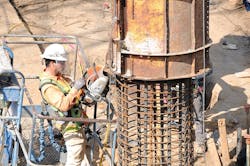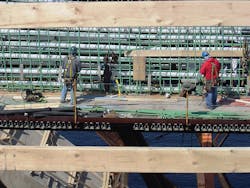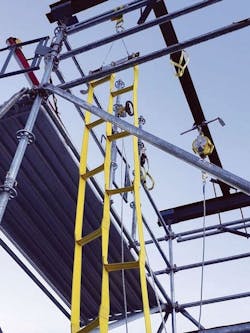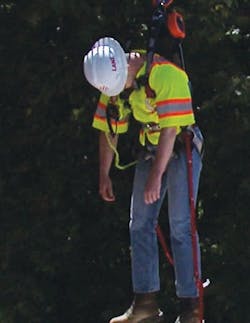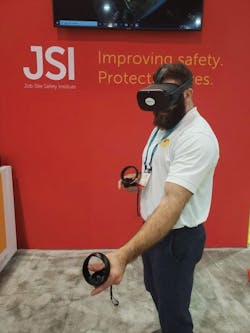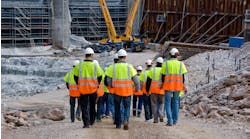A look at the latest in fall protection, prevention, and training in work zones
By: Tim Bruns
Just a few years ago at World of Concrete, Matt Murphy, president of SEE Inc., walked into one of the show booths and observed a demonstration of a virtual reality (VR) simulation for fall protection training in work zones.
At first glance, Murphy thought the technology looked a bit “hokey.”
“I figured the person with the headset on was probably an actor, and there was no way this ‘video game’ was making a fully functioning adult actually shake and get nervous,” Murphy told Roads & Bridges. To his surprise, however, when Murphy had a go with the headset, he found himself sucked in immediately. “I was [virtually] standing on a high-rise building looking down at cars passing and hearing construction activity around me and someone yelling for me to hurry up and bring them a tool,” he said.
During this experience with the VR simulation, Murphy was placed in another scenario and the first thing he saw was a hook on his chest. He grabbed the hook, tied himself off, and went to move forward. At this point, he experienced his first virtual fall.
“Thankfully I had tied off in the scenario, so when my walking surface failed I was only dropped until my lanyard grabbed me,” Murphy said. “I can tell you my stomach felt like I had just dropped three floors. There was no shock that the lanyard would put in your body but the fall felt real. There may have been a loud colorful word that escaped my mouth when I fell. I felt my heart pound and was very happy to remember this was all virtual.”
After this initial experience, Murphy realized that training construction workers on fall protection with this technology was the only way to put someone in such a hazardous situation safely. His company, Safety Environmental Engineering Inc. (SEE Inc.), has had decades of experience providing safety and safety education solutions for the construction industry. The work at SEE Inc. includes training construction workers on OSHA requirements for fall protection on a jobsite, as well as fall protection rescue training. For SEE Inc., the VR simulator technology has advanced the fall protection training experience for road and bridge workers.
THE NEED FOR FALL PROTECTION
One of the transportation construction industry associations that is known to emphasize and educate the industry on work-zone safety, including fall protection, is the American Road & Transportation Builders Association (ARTBA). Through the association’s National Work Zone Safety Information Clearinghouse—known for its annual National Work Zone Awareness Week (NWZAW)—ARTBA and its partners provide a series of resources on fall protection and fall prevention in road and bridge construction work zones.
“In my 30 years in construction, falls have never not been a top concern, if not the top concern,” Brad Sant, ARTBA senior vice president for safety and education, told Roads & Bridges. “However, I think in the last six or seven years, there’s been really some excellent concerted efforts by the industry to work together to address those concerns.” Sant pointed to OSHA’s partnering with the National Institute for Occupational Safety and Health (NIOSH) on the industry’s annual National Safety Stand-Down, which takes place each May. The event is coming up on its 8th anniversary. The Safety Stand-Down provides employers an opportunity to talk directly to employees about safety by taking a break from work to focus on fall hazards and reinforcing the importance of fall prevention, according to OSHA.
Sant notes that for the transportation construction industry, falls are not the number one hazard to workers. “While across the construction industry in general falls are by far the biggest hazard—both for deaths and injuries—in transportation construction, it’s not; that’s the number two hazard,” Sant said. He explained that struck-by incidents are the number one hazard for road and bridge construction workers.
The fall prevention resources provided by ARTBA’s Safety Information Clearinghouse mainly focus on bridge work, and include details on the types of fall protection systems that protect workers on bridges. It divides fall protection systems into two categories: fall prevention and fall arrest systems. ARTBA says the two main types of fall prevention systems in bridge work are guardrails and personal fall restraint systems (PFRS). The main types of fall arrest systems—which are designed to stop a fall after it has occurred—for bridge work include safety nets, personal fall arrest systems (PFAS), and work positioning devices.
PFRS works to prevent users from falling any distance, keeping a worker’s center of gravity from reaching a fall hazard, according to ARTBA. These systems act as a leash and include anchorage, a body harness, connectors, and a lanyard or lifeline.
PFAS are designed to catch a fallen worker and hold them until rescued. These systems do not prevent falls, but greatly reduce their impact. Like restraint systems, the arrest systems include anchorage, a body harness, and connectors. They also include descent and rescue devices used to retrieve or lower a fallen worker.
“Sometimes the real question is when you have a personal fall arrest system, what are you attaching it to and how are you attaching it,” Sant said. “Are you moving? Do you need multiple lanyards so you’re always connected if you’re moving from place to place so you can kind of trade off with your connections?”
In addition to PFAS, other forms of fall arrest systems include safety nets, which can catch workers after a fall when hung beneath or around work areas on a bridge. In addition, positioning devices are body harness systems that allow a worker to be supported on an elevated vertical surface (e.g., a wall).
Matt Murphy said he has seen road and bridge builders using beam clamps workers can tie off to if they are working with steel. “They want to get the lifeline above their head; there’s some devices out there that clamp onto the beam, then they tie back and actually get that anchor point up to 7 ft,” he said. “I also think a lot more of the [road and bridge] workers out there are using the retractable lanyards that work kind of like a seatbelt in your vehicle so they’re not waiting for that full 6 ft of force—you know that thing’s grabbing them almost right away when they fall.”
WHAT ABOUT FALL RESCUE?
ARTBA’s resources on fall protection include a sample fall rescue plan for bridge work. Some of the examples of the way a fallen worker can be rescued include self-rescue; assisted self-rescue with a mechanically aided hauling/rope system that is manually operated; rescue with a manual mechanically aided hauling/rope system by a member or members of a rescue team; or an assisted rescue with a mechanically aided aerial work platform.
From Matt Murphy’s experience, he says having the proper gear, equipment, and mindset are crucial for preparing and implementing fall rescue. “If it’s something where you’re going to have aerial lifts that can reach up from the road and you’re doing that sort of bridge work, then obviously you can rescue from that,” Murphy said. “But if you’re working over water, how are you going to get that person down? So it’s going to be a big difference depending on what’s your position, what’s your work zone.” Murphy says he knows of several bridge workers that now use a specific type of cantilever scaffold system that wraps from the top of the bridge and comes back down, around, and underneath. “They’re using a lot more different types of scaffolds in that setup so they don’t necessarily put themselves in that fall danger as much because they have that full platform to work from,” he said.
According to Brad Sant, fall rescue plans will be determined by hazard assessments conducted by contractors for a particular project or work zone. Self-retracting lifelines are most commonly used for their ease of use and ability to allow workers to rescue themselves, according to Sant. “I guess the warning that we put out there is once that person falls, you’ve got about five minutes before you have to have something in place, because then those body harnesses can start constricting blood flow and even though the worker’s been saved, that restriction on the blood flow through sitting in the harness can actually cause fatalities after they get down if that blood flow has been constricted for too long.” Because of this, Sant said it is important for contractors to have plans in place for how to rescue workers once they fall and are saved by a fall arrest system.
TRAINING AND VIRTUAL REALITY
When it comes to training for fall protection, the resources from ARTBA’s Safety Information Clearinghouse at workzonesafety.org include a series of fact sheets that can be assembled for training. “There’s a whole series that covers all these aspects—everything from fall rescue, to how to choose your personal fall arrest system, to how to properly install guardrails,” Sant said. In partnership with FHWA, ARTBA has also developed a comprehensive fall training program through an OSHA grant that Sant says will be offered to the public for free.
Matt Murphy’s company, SEE Inc., has been using VR simulators for fall protection training in just the last few years.
According to Andy Sigler, Director of Field Operations and Safety Consultant for SEE Inc., there are a few different scenarios that the VR simulator can put trainees through. The first scenario allows for workers to virtually inspect their equipment for safety. “Once you get done inspecting it, then you actually go into the field concept of it,” Sigler told Roads & Bridges. “You actually walk up onto a stage—you can select your fall protection from there—clip onto an actual anchor point and a lanyard, and then you can walk across the beam.”
Sigler said trainees can also virtually experience fall protection devices doing their job by preventing the worker from falling or catching them as they fall. In addition, trainees can get a virtual taste of falling after not being tied off properly with fall protection equipment on a jobsite. “It’s one of those situations where if you’re doing it, you’ve got to be careful about the employee because they’ll freak out—it feels like they’re literally falling.”
“We’re still working with companies to develop different types of virtual reality training because I think it’s going to be second to none to be honest with you,” Murphy said. He added that his company has demonstrated the technology at various trade shows over the past few years. “We put people through it on the floor, and it was a huge draw and everybody who went through it loved it—they were just really impressed.”
About The Author: Bruns is associate editor of Roads & Bridges.

